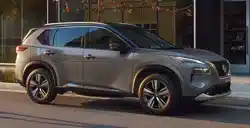Loading ...
Loading ...
Loading ...

5-126 Starting and driving
the vehicle in accordance with these
system limitations could result in
serious injury or death.
. The AEB with Pedestrian Detec-
tion system cannot detect all
vehicles, pedestrians or cyclists
under all conditions.
. The AEB with Pedestrian Detec-
tion system does not detect the
following:
— Pedestrians that are small (for
example, children), in a sitting
position, operating toys/ska-
teboards, on scooters or in
wheelchairs, or not in an up-
right standing or walking po-
sition.
— Animals of any size.
— Obstacles (for example, cargo
or debris) on the roadway or
roadside.
— Oncoming or crossing vehi-
cles.
— Vehicles where the tires are
difficult to see or the shape of
the rear of the vehicle is un-
clear or obstructed.
— Parked vehicles.
. The AEB with Pedestrian Detec-
tion system has some perfor-
mance limitations.
— If a stationary vehicle is in the
vehicle’s path, the system will
not function when the vehicle
approaches the stationary ve-
hicle at speeds over approxi-
mately 50 MPH (80 km/h).
— Pedestrian and cyclist detec-
tion will not function when the
vehicle is driven at speeds
over approximately 37 MPH
(60 km/h) or below approxi-
mately 6 MPH (10 km/h).
. For pedestrians, the AEB with
Pedestrian Detection system will
not issue the first warning.
. The AEB with Pedestrian Detec-
tion system may not function
properly or detect a vehicle, pe-
destrian or cyclist ahead in the
following conditions:
— In poor visibility conditions
(such as rain, snow, fog, dust
storms, sand storms, smoke,
and road spray from other
vehicles).
— If dirt, ice, snow, fog or other
material is covering the radar
sensor area or camera area of
the windshield.
— If strong light (for example,
sunlight or high beams) en-
ters the front camera or a
sudden change in brightness
occurs (for example, entering
a tunnel or driving in light-
ning).
— In dark or dimly lit conditions,
such as at night or in tunnels,
including cases where your
vehicle’s headlights are off or
dim, or the tail lights of the
vehicle ahead are off.
— When the direction of the
camera is misaligned.
— When driving on a steep
downhill slope, on roads with
sharp curves, and/or bumpy
or dirt roads.
— If there is interference by
other radar sources.
— When your vehicle’s position
or movement is changed
quickly or significantly (for
example, lane change, turning
vehicle, abrupt steering, sud-
den acceleration or decelera-
tion).
Loading ...
Loading ...
Loading ...
